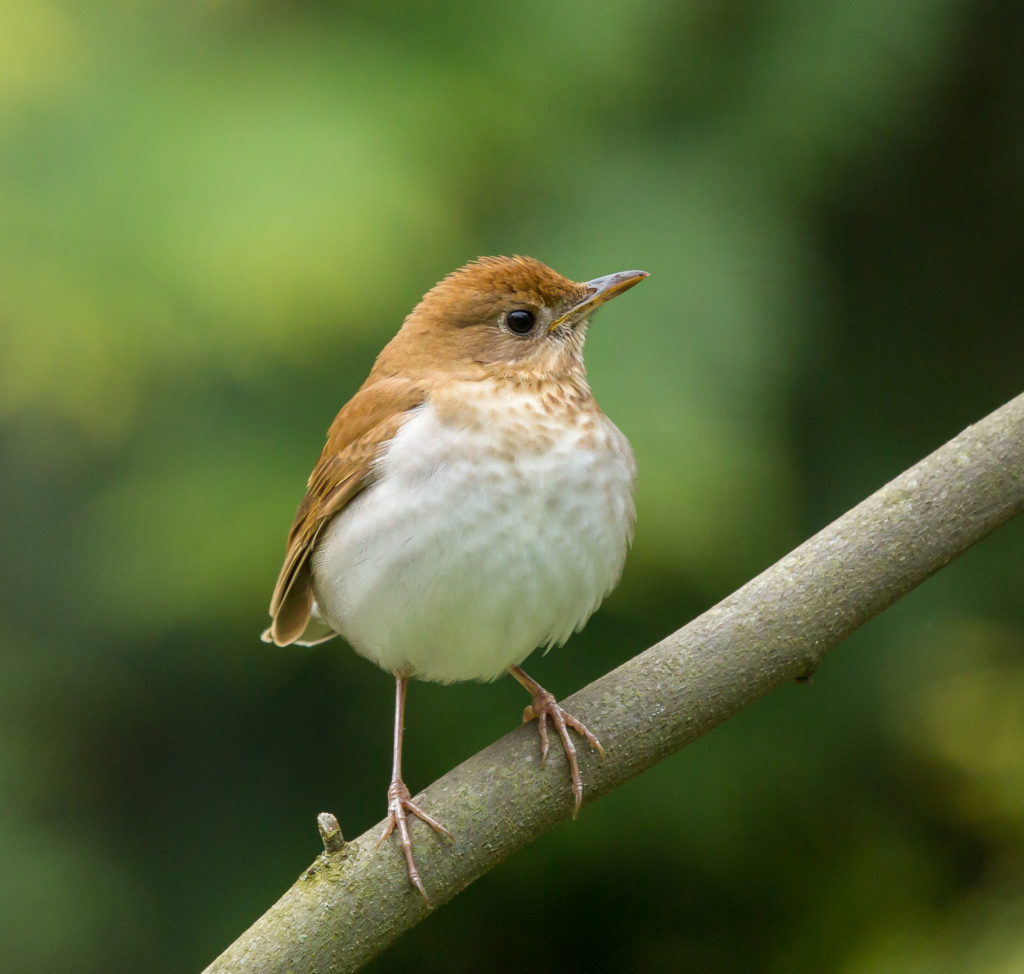Photographing A Veery Thrush
I was very pleased to spot this Veery Thrush in our yard, if only momentarily, because this species is a rather infrequent visitor here. They forage like Robins, on the ground flipping over leaf debris to uncover insects and worms underneath. According to E-bird, Veery Thrushes spend their winters only in Central and Southern Brazil and nest throughout Michigan, in the Northern US, and Southern Canada. This was my first photographic encounter, and it was made to order.
This handsome, cinnamon brown thrush first appeared on a branch near our dining room window. I hurried to the library door, then abruptly changed my pace and posture so that I was tiptoeing slowly and ducking down so as not to startle him as I made my way to the camera. (NOTE: I did this despite every instinct inside urging me to hurry before he flew off.) Once I reached the camera, all I had to do is point, lock focus and burst away.

ISO1600; f/7.1; 1/640 Second
What is Bursting?
The FPS (Frames per Second) is the speed at which the camera shutter mechanism can take uninterrupted shots. The Burst Rate specifies how many uninterrupted shots the shutter mechanism can discharge without slowing down.
FPS and Bursting are all about how fast and how many- and that means that DSLR cameras must have fast processing power and design logistics calculated to eliminate bottlenecks.
Advantages of Bursting
- Bursting can be useful and fun..and for the most part, it’s FREE.
- In bird photography, you just don’t know how long your subject will stay put. Bursting allows you to capture many images in seconds.
- Bursting is essential to record a sequence and tell a story – during a period that is most likely to be a brief and rare opportunity.

ISO800; f/7.1; 1/500 Second
Some Things to Consider when Bursting
- Inherent mechanical limitation of camera’s shutter device. (NOTE: My cameras’ shutters are rated at 150,000 actuations.)
- Data processing speed of camera’s processor.
- Within one burst, no adjustments can be made to aperture and shutter settings. (As you can see in the notes below the photos, the shutter speeds are different for the photos….. which means that these photos were taken in separate bursting sessions.)
- Continuous bursts will capture a lot of identical photos- unless the action is really fast.
- Max burst and FPS touted by camera manufacturer will slow if your shutter is set to a slower speed.
- If you’ve got 2 memory cards installed and/or are writing to 2 memory cards, processing will slow down.
- If your camera is set to RAW; processing will take longer to move through the much larger files.
- If the camera stops, it has most likely reached a bottleneck due to an overload of files, or does not have enough battery power to proceed.
- Slower memory cards with limited read/write speeds will create bottlenecks.
- A half charged battery will slow down processing…. and the battery will drain quickly if bursting continues.
- Whenever a camera has to re-meter and/or re-focus, bursting slows down. (In Canon cameras, AlServo auto focus will slow down fps- especially if it must keep trying to lock focus.)
- The hidden cost with bursting: The photographer must devote lots of time in post processing to review all those images.
- Bursting often places the photographer in “auto mode”, where the discipline to capture outstanding bird images may be put on hold.
- Ultimately the burst will stop… no matter the sophistication of the camera.
Choices – How Fast? How Quiet?
Assuming a bird photographer has a DSLR camera designed to burst and then move data through fast, there are also choices about what burst mode is best for bird photography. You can choose between High Speed Continuous and Low Speed Continuous burst mode…. or really slow down and choose Silent High Speed Continuous or Silent Low Speed Continuous burst mode.
I use to think that the louder shutter slapping sound would scare away birds, so I always set the camera to Silent Continuous burst mode. I don’t do that anymore because the silent modes are not noiseless. When set to Silent HS continuous or Silent LS continuous, the striking sound is a muffled slap..definitely more diminished, but you and the birds will most certainly hear it.
When to Use Bursting
When I first spot a bird, I always assume that the encounter will be fleeting. My camera is usually set to Low Speed Continuous Burst Mode, just in case I need it. Once I lock focus on a bird, I press and hold the shutter down and hear that machine-gun staccato burst from my shutter mechanism. If the bird does not fly away, I am more judicious as to how much I use bursting.
Depending on the scenario, the bird photographer must decide. Will I end up with more usable bird images with or without the camera set to burst mode?








